Introduction
Xtrfy products seem to go under the radar a bit. There are a good number of professionals using their gear (especially if you consider the fact that Xtrfy is still a bit of a niche brand) and their products are met with general praise pretty much every time that they release something new, but mainstream appeal seems to elude Xtrfy mice for the time being. It’s a shame, since they release some extremely interesting products.
Today, we’re taking a look at the wireless version of a mouse that released a while ago: the M42. While giving it the wireless treatment, Xtrfy have also upgraded a couple of aspects. The wireless versions comes with Kailh GM 8.0 switches, a 3370 sensor, and a revamped customization system. All of this is offered at an attractive price, so in theory there’s plenty to love about this newest release. We’ve sent the mouse over to our reviewer to find out if practice follows theory. Read our full Xtrfy M42 Wireless review to find out everything that you want to know about the mouse!
At A Glance
Xtrfy M42 Wireless
Used by 1 player ()The Xtrfy M42 Wireless not only is a meaningful upgrade when compared to its wired predecessor, it’s also simply one of the best gaming mice out there at this point in time if you’re asking me. It has fantastic clicks, a great scroll wheel, reliable build quality, good stock feet, a flawless sensor, and a spotless wireless connection. If you’re looking for a small ambidextrous wireless mouse to game with then this should be near the very top of your list without a doubt.
Pros
- Great clicks
- Great scroll wheel
- Good stock feet
- Solid build quality
- Flawless gaming performance
Cons
- Button customization feels janky and unreliable
- Movable battery balance feature feels like a gimmick
- Holes will annoy some users
Specs
| Sensor | PMW 3370 |
|---|---|
| DPI | 400, 800, 1200, 1600, 3200, 7200, 19000 |
| Polling Rate | 125 / 500 / 1000 Hz |
| Button Switches | Kailh GM 8.0 |
| Button Force | 78.6g |
| Connection | Wireless |
| Shape | Ambidextrous |
| Length | 11.17cm |
| Height | 3.75cm |
| Weight | 68g |
| Width | 5.59cm |
First Impressions
In a time where manufacturers are pulling back on the amount of holes that they drill in their shells it’s becoming a bit of an oddity to see a full ‘cheese grater’ mouse. The M42 wireless is almost all holes, and the only portion of the mouse that isn’t covered in them is the front part where the main clicks are. Given the fact that I’ve seen my fair share of gamers complaining about having holes on ‘pressure points’ (i.e. the sides where your grip is the strongest) of a gaming mouse and the fact that having holes on the sides doesn’t do wonders in terms of weight it’s a bit of a letdown to see that Xtrfy haven’t removed those side panel holes. I personally don’t mind them, but I know a lot of people that do, so right off the bat they’re alienating a portion of potential customers. I get that the whole ‘holes’ thing is also a way to market mice (even though it’s quite obvious that having these holes also reduces the weight, so it’s not as if it’s a complete gimmick) but that could perfectly be achieved by just having the back portion be of the mouse be honeycombed. Anyway, like I said: it’s not an issue for me, but I just thought I’d mention it.
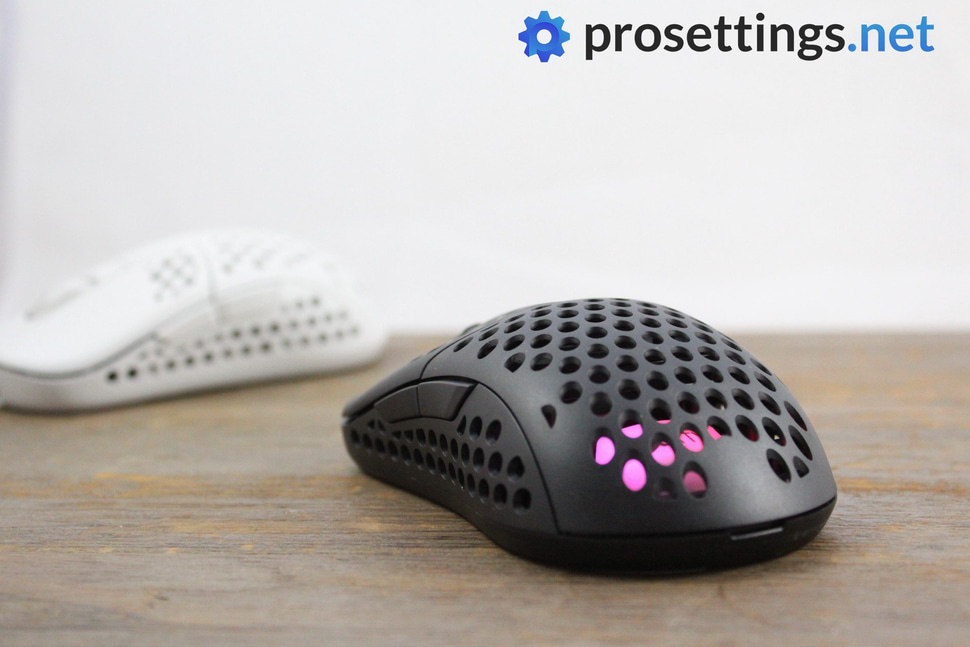
What is an issue for me is that many of the (cosmetic) problems that I had with the M4 Wireless are still around on the M42 Wireless. When the mouse arrived I immediately tried to swap the shell and front buttons, only to find out that swapping the buttons still feels as if you’re performing open heart surgery: make one mistake and the subject on your table is dead. I suspect that both of these mice (the M42 and M4 Wireless) were developed somewhat at the same time and I know that changing production processes isn’t as easy as renaming a file name on your computer, so I can see why these problems are still there but I would love to see this process changed for future mice.
Packaging
Xtrfy don’t skimp on the things that they include in the packaging. Inside the box you’ll get the mouse, an additional back shell (more on that in the next section), a screwdriver to swap said shells and change the battery balance, a set of replacement mouse feet, the usual information, a sticker, a charging cable, and extension dongle for the (included) wireless reicever, and two special keycaps.
Despite the fact that I can almost fill a keyboard with ‘GG’ and ‘Xtrfy’ keycaps at this point I do like that they include this. It’s a fun little addition. I of course also love the fact that they include replacement mouse feet so that you can easily swap them out if your feet ever get worn out after all that gaming. All in all, Xtrfy are at the top of the game when it comes to the packaging and extras that they include.
Shape and Finish
One of the M42’s selling points is its swappable back shell. If you buy this mouse it comes with two shells: one with a more sudden hump at the back to allow for more palm support, and another with a flatter profile that dials down on the palm support. I think that this is a cool idea and it really helps with making the mouse your own. Xtrfy could’ve just as easily made two separate mice but I think this is better for the consumer as you don’t have to buy two mice to try out.
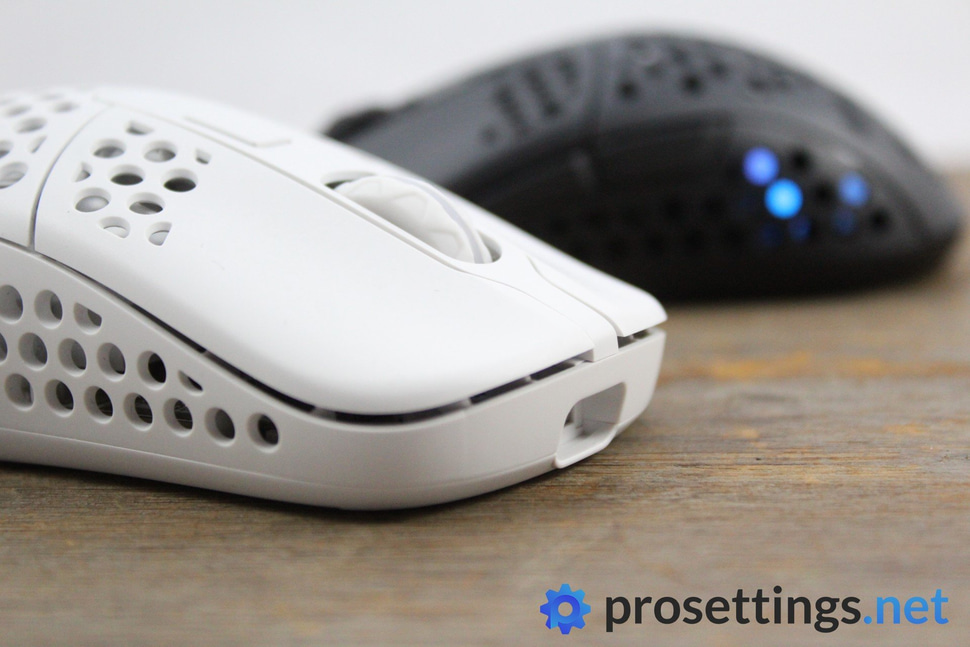
It’s also anything but a gimmick: there’s a big difference between how both of these configurations feel. I personally prefer the version with more palm support (I use a claw grip with my 18×10.5 cm hands) and while it’s not as if the other version is unusable to me I can definitely notice a difference.
Leaving out the back portion for a bit, the M42 is a very neutral mouse. There are no big curves or ridges here, so if you want a smaller ambidextrous mouse then the M42 Wireless is unlikely to offend. There is a bit of curve towards the middle (as is the case with most ambidextrous mice) and the back flares out a touch, but aside from that this is a rather flat-feeling mouse. That’s okay, of course, but if you like your thumb to dig into a shell you might want to consider the fact that you don’t really get that feeling with the M42.
As I mentioned before, the M42’s back shells can be swapped. To do this, you need to undo three screws first. Customizing the back shell used to be done via a simple grab and click system, but Xtrfy have told me that they changed to this screw system because the magnets used in the previous system would weigh too much. That’s perfectly fine as an explanation if you ask me. I don’t think that Xtrfy have intended the customizable aspect to be something that you use every day anyway. To me, it feels like you choose the shell you most like and then you move on. The fact that they use screws means that the shell is in place securely, so I understand this decision.
Something that I don’t really understand (and something that I mentioned earlier in the review) is the button customization. Of course you don’t have to change these buttons: it serves no purpose other than making cosmetic changes, so if you’re fine with the way your mouse looks you never have to touch these buttons. With the way it is right now, I actually recommend you to do just that: leave them alone. I’ve opened up mice that didn’t advertise their customizable buttons that had clickers that were easier to remove so that’s definitely not what you want out of a mouse that advertises its customization options.
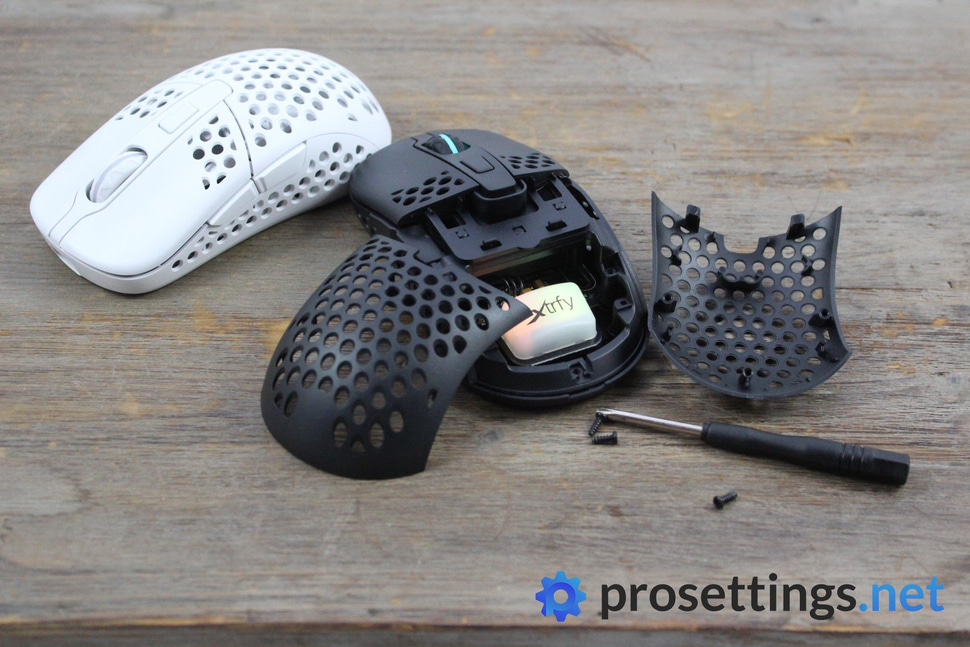
Removing the buttons isn’t all that hard, but shoving them back in requires a lot of wriggling and positioning, and if you do it wrong you risk permanently damaging your mouse/buttons. I applaud Xtrfy for trying to bring customization to their products (a lot of people love to make their gear their own or match it to their particular aesthetics) but it’s just implemented badly here. Swapping the back shell is a breeze (and that’s good, because swapping that actually has a performance impact) but I strongly recommend leaving the buttons alone.
On the bottom of the mouse you’ll find two large PTFE feet that have a fantastic and wonderfully slick glide. I had no issues at all with these. Important to note is that these are different feet than the ones on the wired version, so they’re not backwards compatible.
The matte coating feels great. My hands get a bit clammy when tryharding in games and I had no issues with the mouse (this goes for both the black and the white version) looking or feeling gross after a particularly intense match. I had no issues with grip during my testing either but that’s of course also down to the fact that there’s simply not a whole lot of contact between the actual coating and your hands/fingers; most of this mouse shell consists of holes.
Recommended Grip Types
This is a rather small and ambidextrous mouse, so if you want to palm it you’re going to want to make sure that your hands aren’t too big, but otherwise its neutral and safe shape combined with the customizable back shell should accommodate most grip types. The buttons feel as easy to press towards the back as they do towards the front so you can definitely also fingertip grip it if you want to.
As usual I want to place a disclaimer here: these grip/size guidelines when it comes to mice are merely a suggestion. If you feel like this mouse would suit you then by all means, go for it. Us reviewers post these guidelines as just that: something to go off of when deciding to buy your next mouse. Only you know what you prefer, so it’s important to make a decision that suits you.
Buttons and Scroll Wheel
Gone are the Omrons that were found in the wired version, in are community darlings Kailh GM 8.0. These actuate with a really snappy click, and they’re implemented wonderfully. I noticed no pre-, post- or sideways travel on either of my copies. The buttons feel consistent across their entire surface, and all of those aforementioned qualities combined with the snappier and slightly more reassuring click feeling of the Kailhs when compared to the Omrons make for one of the most pleasing click sets I’ve tested in a while. The side buttons also feel good. The mouse 4 button does feel a bit mushier than mouse 5, but pre-and post travel is limited to an absolute minimum here. These are some really solid side buttons.
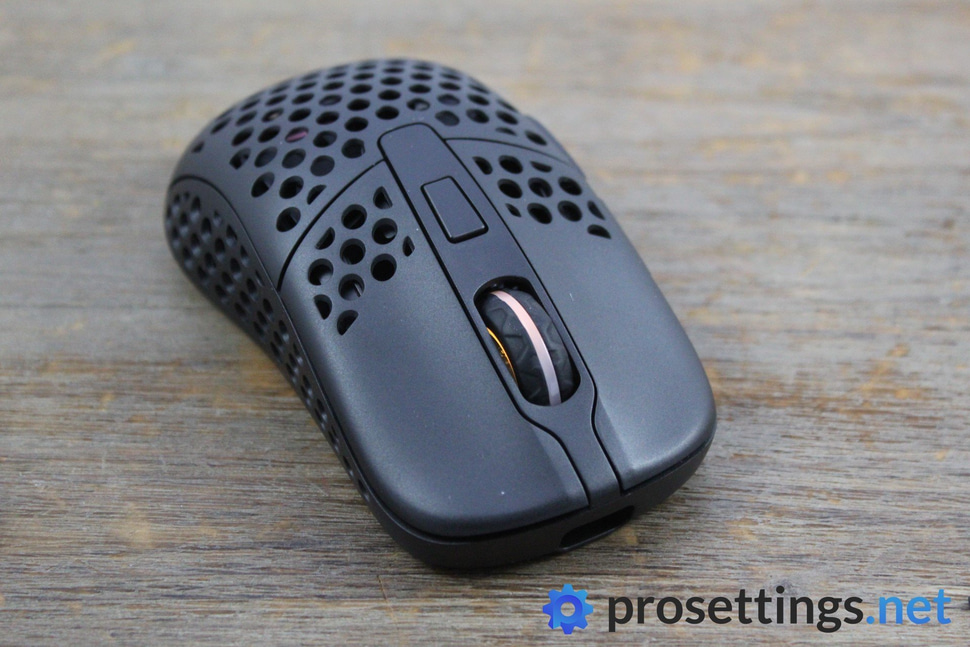
On the top of the mouse you’ll also find an extra button that you can ‘bind’ (by using a selector switch on the bottom) to do the same as page down on your keyboard, so you can use it as an extra input method. Due to its placement I wouldn’t necessarily bind it to crucial abilities that you need in the heat of battle, but it’s nice that the option is there. This button feels noticeably worse than the other buttons: there’s some post travel present, and the click itself also feels rather mushy, but since I don’t know a lot of people who actively use these kinds of DPI buttons ingame I don’t feel as if that’s a big issue.
The scroll wheel, then, continues the parade of good news. It’s almost completely quiet, yet surprisingly tactile. It doesn’t feel like you have to slide it through tiny glass panels with every step but there’s certainly more than enough tactility to notice when you’ve done a step. It also feels a lot easier to press than the scroll button on the wired version, and when pressing the wheel you’ll find that it actuates with a crispy and nicely tensioned (I had no accidental clicking or scrolling issues) click.
All in all, Xtrfy have done a fantastic job with the clicks and the scroll wheel, and it’s one of the better mice that I’ve tested on this front. Click feeling is of course something subjective, and if you like featherlight and easily spammable clicks this might not tickle your fancy, but objectively speaking the M42 Wireless is all aces on this front.
Quality and Cable
Much like its wired sibling, the M42 Wireless feels extremely solid. The bottom plate is a bit thinner, so if you apply a lot of pressure there it can flex a little bit, but that isn’t an issue at all if you ask me since that part of the mouse will never be subjected to those amounts of pressure when using it normally. Shaking or tapping the mouse against your desk also does not reveal a single defect at all. I even held my ear really close to the shell to see if I could hear something but there’s nothing on my test copies. This is one of the sturdiest feeling ultralight mice I’ve seen.
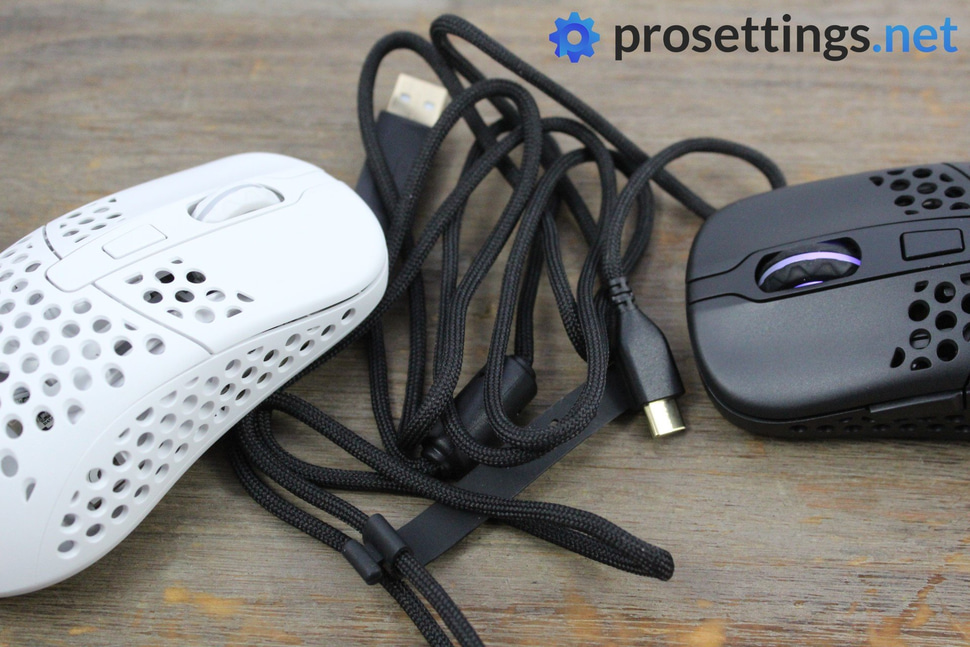
The included charging cable is Xtrfy’s USB-C EZCord Pro (and the cutout on the mouse itself is wide enough to allow for other USB-C cables to charge the mouse) and it’s also decently thin and flexible, so if you have to use the mouse when charging it you definitely can, even when you’re gaming.
A standout feature that Xtrfy’s wireless mice have is that you can change the position of the battery somewhat, and that allows you to change the weight balance of the mouse. You do this by loosening two screws (with the included screwdriver) and moving the battery, and while it does alter the feeling of the mouse when resetting from swipes it’s not a lifechanging addition if you ask me. It also feels a bit finnicky to move said battery, so this is something they can improve on in the future.
Performance and Sensor
The 3370 optical sensor is the de facto default wireless sensor for brands that haven’t (yet) developed their own sensors. It makes sense, as it’s a flawless sensor that draws less power than previous ‘standard sensors’ that were found in wired mice. This particular 3370 is implemented as it should be, and I noticed no sensor issues at all.
Xtrfy’s wireless tech is also pretty impressive. Some wireless mice from other smaller brands can sometimes take a bit to ‘wake up’ after a period of inactivity, for example, and that’s not even the case here. These things don’t impact performance, but it is indicative of a nice and responsive wireless design if you ask me. I never had any problems with the mouse dropping its connection or lagging behind, despite having about three other wireless mice plugged in during my testing. The performance of the M42 Wireless is completely trustworthy at all times.
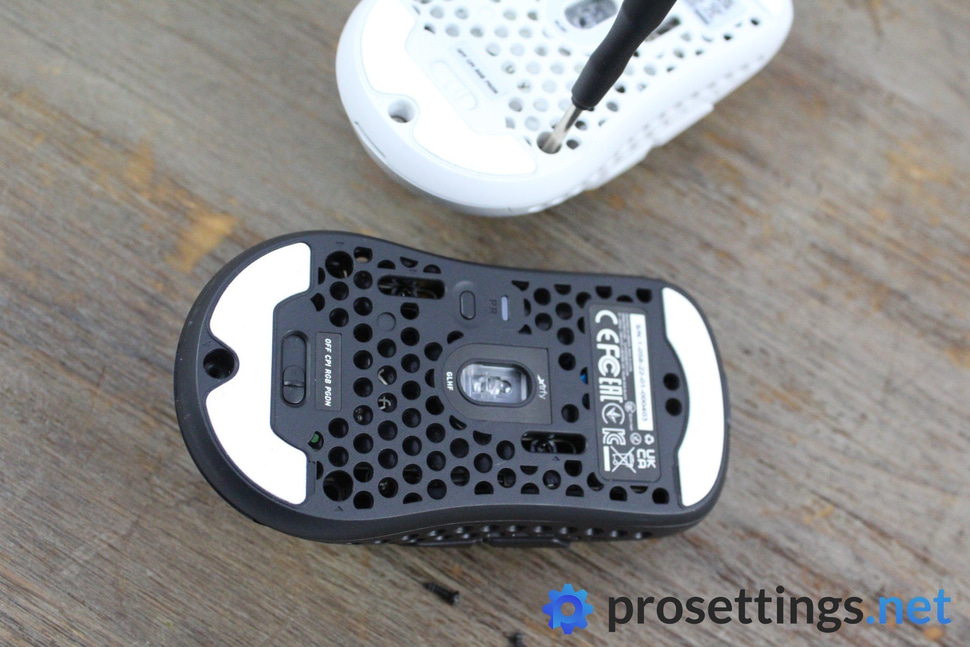
Xtrfy’s products are all plug and play. That’s a breath of fresh air for someone who has to review a lot of products (I think I have pretty much every driver program installed on my PC right now) but if you like your button rebinds or macro recordings you’re not going to be able to do that with the M42 Wireless. Configuring the mouse can be done by selecting what it is that you want to configure (by means of a slider on the bottom) and then pressing the ‘DPI button’ on top of the mouse. Once you’re done you can let that DPI button act as the page down button on your keyboard so that you have an extra input option. It’s perhaps inconsequential to most gamers (I don’t know many players who tend to use that button ingame) but it’s an intuitive way to repurpose that otherwise useless DPI button on plug and play mice.
One thing that does really annoy me is the charging animation. When you charge the mouse its RGB goes into a charging mode, whereby the RGB elements go dark and then flash orange momentarily until it’s completely charged. There’s no way to change this, and it’s really distracting. I think a subtle color fade (to indicate the charging status) without the full brightness flickering would be much more palatable. I know that it’s nitpicky and it won’t influence my opinion on the mouse itself, but it feels like something that’s easy to change so I’m going to mention it again since I also had this issue with the M4 Wireless.
Conclusion
The Xtrfy M42 Wireless not only is a meaningful upgrade when compared to its wired predecessor, it’s also simply one of the best gaming mice out there at this point in time if you’re asking me. It has fantastic clicks, a great scroll wheel, reliable build quality, good stock feet, a flawless sensor, and a spotless wireless connection. If you’re looking for a small ambidextrous wireless mouse to game with then this should be near the very top of your list without a doubt.
It’s not without its faults, but luckily these faults don’t really impact the performance, unless you’re someone who dislikes the feeling of having holes in a mouse (I really think they should remove those on the sides) or you want to create a bunch of macros and rebind your buttons. The button customization system feels very janky to say the least, for example, and the movable battery aspect could also be implemented in a smoother and more user-friendly manner if you ask me. But those are all optional extras. You don’t have to swap those buttons and the weight balance is just fine out of the box.
This is yet another hit by Xtrfy, and one of my personal favorite gaming mice.
This product was received for free from the manufacturer and given to our reviewer to test and review. Brands and manufacturers have no editorial control over our reviews. For more information, check out our review FAQ.


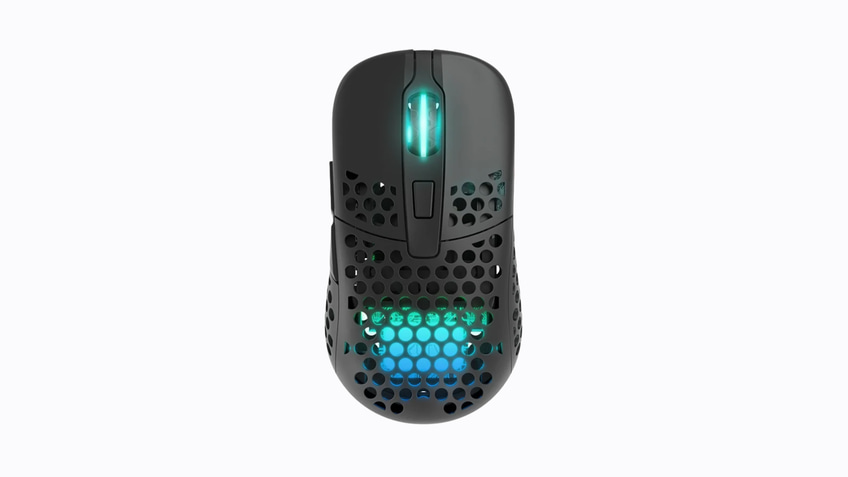


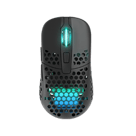


Which is better to get Logitech G Pro X Superlight or Xtrfy M42 Wireless
That depends on a couple of factors, to be honest. Both are extremely good gaming mice, though I like the M42’s shape better and I am also not bothered by the holes. Spec-wise it’s difficult to tell the two apart if you’re looking purely at gaming performance so it’ll come down to what you prefer when it comes to features and, most importantly, the shape.